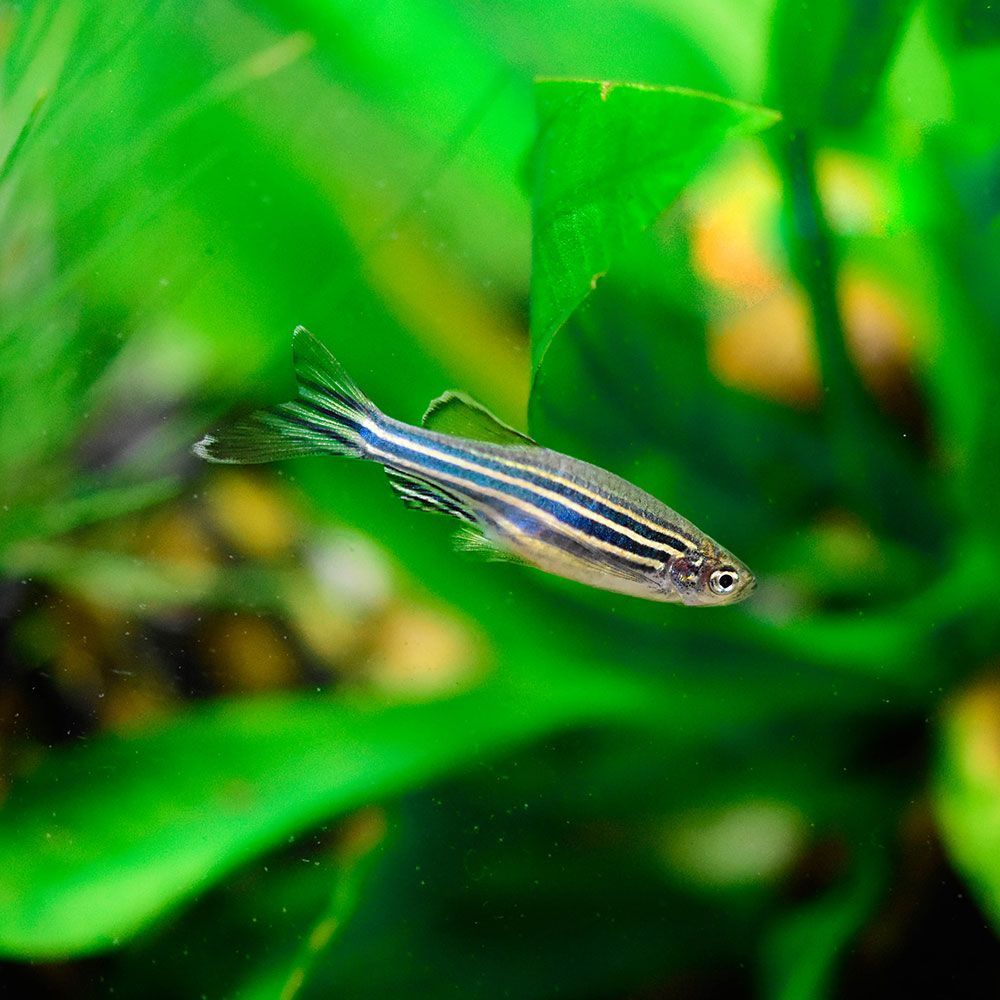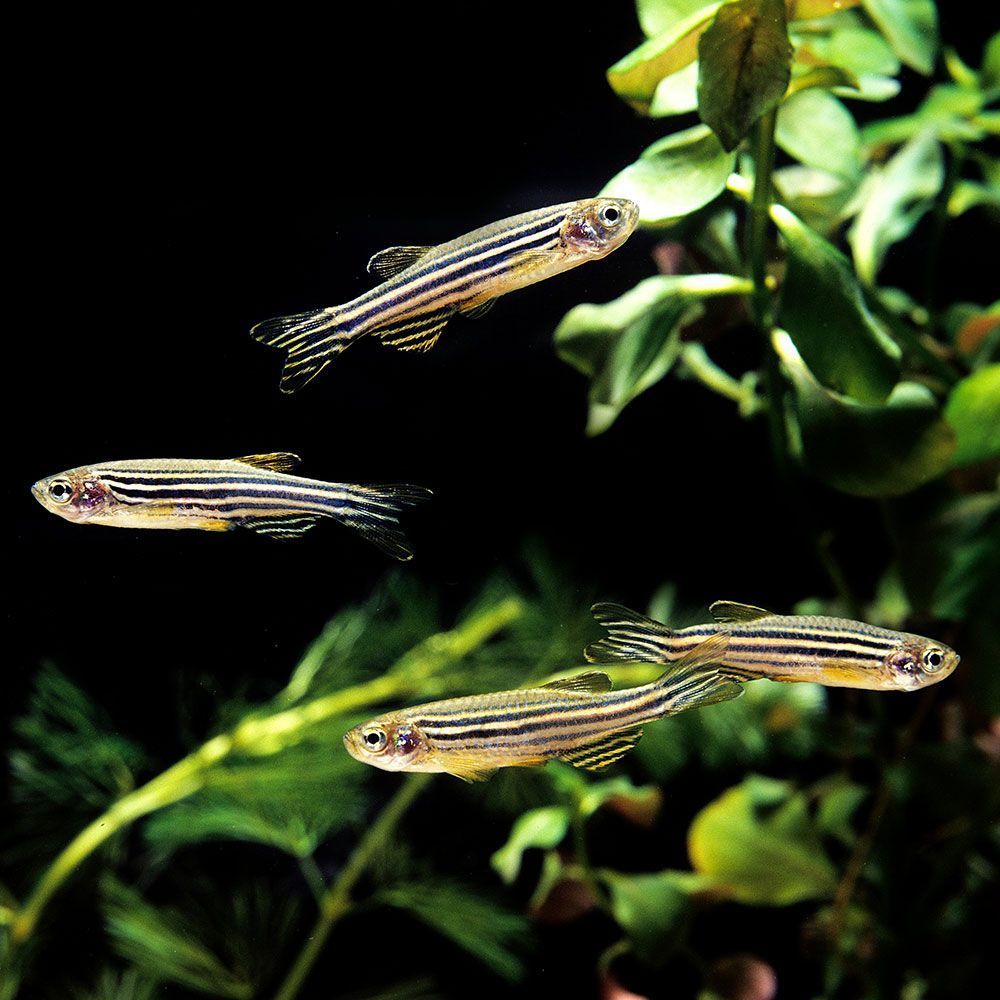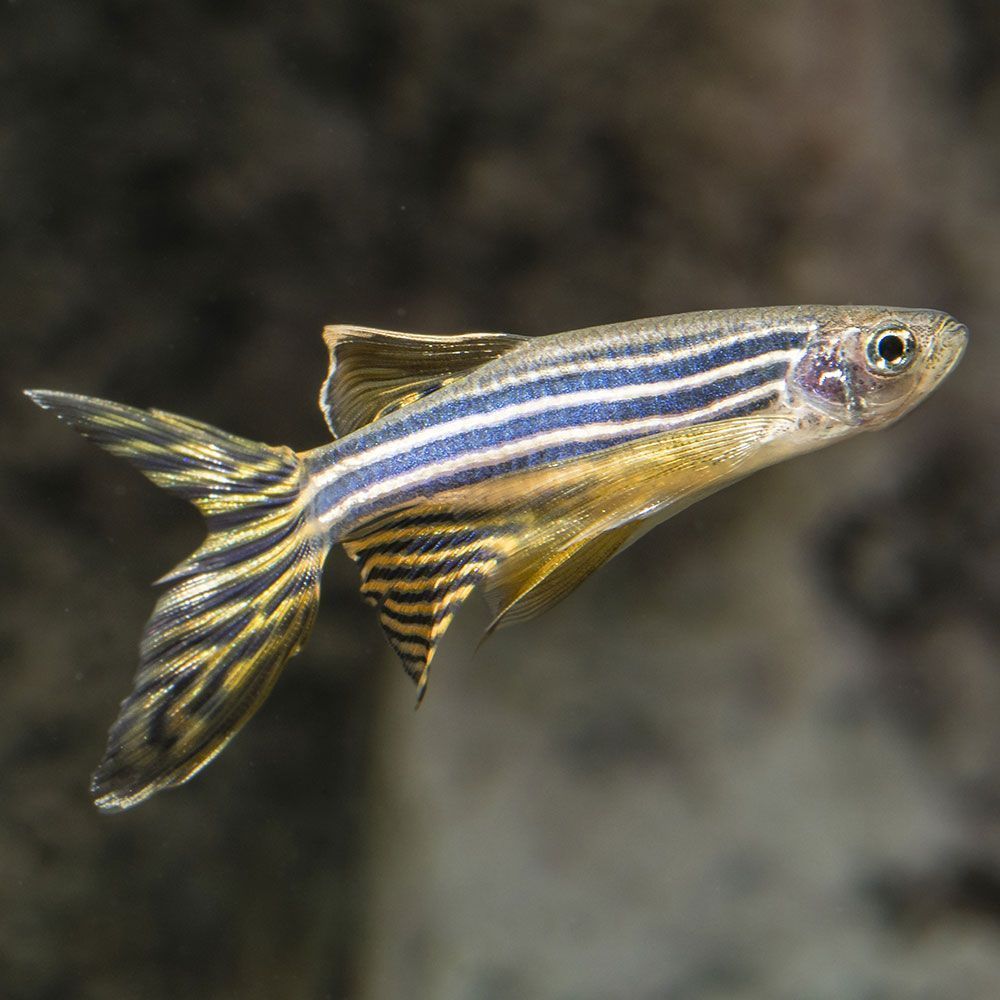If you are looking for a vibrant and energetic fish for your peaceful freshwater community tank, then zebra danio must be on top of your list!
This fish is recognized as a dither fish, i.e., it reduces tension, encourages playfulness in shy fish, relaxes potential aggression, and promotes harmony in the tank. It is also super easy and fun to breed and feed them.
What are the main characteristics of Zebra Danio fish?
| Origin | India, Myanmar, Pakistan, Bangladesh, Nepal, and Bhutan |
| Order | Cypriniformes |
| Family | Cyprinidae |
| Scientific Name | Danio rerio |
| Common Names | Zebra fish, zebra danio, zebra, striped danio, rerio, and leopard danio |
| IUCN Red List Status | Least concern |
| Appearance | Primarily silver-gold colored, slender, elongated body, mouth oriented upward; five horizontal stripes, striped anal fin |
| Size | Up to 5 cm (2 in), 1.8-3.8 cm (0.7-1.5 in) in the wild |
| Lifespan | Up to 2-3.5 years in captivity; Over 5.5 years with the best care |
| Temperament | Peaceful |
| Tank Level | All levels |
| Water Temperature | 64-75 °F (18-24 °C) |
| pH Level | 6-7.5 |
| Water Hardness | 6-12 dGh |
| Care Level | Easy |
| Minimum Tank Size | 10 gallons for 5 of them |
| Tank Environment | Well-decorated tank with natural-looking items like driftwood, plants, rocks, bogwood, etc., and plenty of space to hide. |
| Diet | Omnivorous, prefers live prey and insects |
| Tank Mates | Own group of 8-10; peaceful, tolerant species |
What is the Natural Habitat of Zebra Danio fish?
The zebrafish thrives in sub-tropical and tropical freshwater habitats across South Asia, including India, Pakistan, Bangladesh, Nepal, Myanmar, and Bhutan, with its range spanning the Ganges and Brahmaputra River basins.
While native to these regions, it has been introduced to areas like the United States, Colombia, and Malaysia.
It prefers swimming actively in clear, shallow waters with moderate flow. It’s typically found in streams, canals, oxbow lakes, ponds, and rice paddies.
It’s a benthopelagic fish, so in its natural habitat, it feeds at the water’s surface, bottom, and in between.
It seeks shelter among submerged or overhanging vegetation and inhabits the sandy, muddy, and pebbly lower reaches of the water body.
Zebra danio maintains a Least Concern status on the IUCN Red List (assessed last in 2009) due to its stable native populations.
How do you classify Zebra Danio fish?
Scientifically known as Danio rerio, this species belongs to the family Cyprinidae within the order Cypriniformes.
This fish is recognized by a variety of common names all over the world, like zebra fish, zebra danio, zebra, striped danio, rerio, and leopard danio.
Fun Fact: Zebrafish can regenerate fins, heart tissue, spinal cord, and even parts of their brain, making them a valuable model for studying tissue regeneration in vertebrates.
How does Zebra Danio fish look?

Now if you are intrigued to know more about the beauty of the fish, let’s get into the details.
What is the size of Zebra Danio fish?
Zebrafish usually measure between 1.8-3.8 cm (0.7-1.5 in) in the wild, although they can grow up to 5 cm (2 in) in captivity.
What is the color of Zebra Danio fish?
Zebra danio showcases a variety of captivating colors. The naturally found zebra is primarily silvery-gold, adorned with distinctive blue stripes.
The fish is bred in different shades, like silvery green, pink, blue, and purple. All different types have black and white stripes accompanied by different colored borders in between. There are also albino and golden varieties available.
Another variety is leopard, where the fish has black spots sprinkled all over the body.
Zebrafish is also modified to introduce a fluorescent pigment into its DNA which makes it glow in UV light. This is exactly why it is also known as GloFish and has orange, green, blue, purple, or red body colors along with dark stripes.
How to identify Zebra Danio fish?
The zebra danio has a slender, elongated body with its mouth oriented upward, resembling that of a fusiform shape.
It possesses five eye-catching horizontal stripes running along its side, which look like the stripes of a zebra. These stripes extend seamlessly onto the caudal fin.
The anal fin is also uniquely striped, but it does not have a lateral line along its body.
The rostral barbels of the zebra danio fish extend to the front edge of the eye, while its maxillary barbels terminate around the middle of the opercle. Its anal fin rays are of a branching pattern.
The standard zebra danio features short, rounded fins and a rounded tail.
The longfin zebra danio, a breed developed through captive breeding for aquariums, boasts elongated, flowing fins and an extended tail. The longfin zebra danio’s tail is about three times longer than that of the common zebra danio.
How is a Male Zebra Danio fish different from a female?
The male zebra danio fish shines in a brighter golden color, while females display a softer silvery-white hue.
The male has a sleek, torpedo-like shape with golden stripes between the blue ones.
On the other hand, females have a bigger, pale belly and silver stripes instead of gold. Mature females also show a small protrusion of genital papilla in front of where the back fin. Their bellies become round when filled with eggs.
How does Zebra Danio fish behave in the tank?
Zebra danio is lively and playful and exhibits friendly behavior in community tanks. It darts around the tank throughout the day, exploring every nook and cranny of the tank.
While generally peaceful, the fish has a tendency to nip at the fins of other long-finned slower-moving species.
Within its group, the fish establish a hierarchy through non-aggressive behaviors like playful sparring and chasing.
It also stimulates playful interactions among timid fish and promotes a sense of ease in more aggressive species. Its vibrant and energetic demeanor contributes to maintaining a harmonious environment within the aquarium.
What is the Lifespan of Zebra Danio fish?
In captivity, zebrafish typically live for 2-3.5 years, but with good care, this can extend to over 5.5 years.
Author’s Note: When several male zebrafish are housed together, they compete by exhibiting brighter colors to attract the females.
How to take care of Zebra Danio fish?

Now, if you’re ready to bring this fish into your care, let’s begin creating its home, right here!
What is the Tank Size for Zebra Danio fish?
House zebra danios in groups of 8-10 and provide a minimum tank size of 30 gallons. If you are adding more fish, ensure each fish has a minimum of two gallons of tank space, preferably more.
Create a spacious swimming area with plants and decor at the edges to keep them happy and healthy. A crowded tank raises risks like waste buildup, water issues, infections, and aggression.
What is the Water Chemistry for Zebra Danio fish?
Next, your job is to provide pristine water conditions to help your zebra fish live the longest. So, follow these parameters at all times!
- pH Levels: 6-7.5
- Water Temperature: 64-75 °F (18-24 °C)
- Water Hardness: 6-12 dGh
- Ammonia: 0 ppm
- Nitrite: 0 ppm
- Nitrate: Below 20 ppm
What is the Tank Environment for Zebra Danio fish?
The right aquarium setup also greatly influences your pet fish’s well-being and disposition. So, let’s craft an optimal environment for their happiness and health!
Which Substrate to use for Zebra Danio fish?
The optimal substrate for zebra danio is fine, soft sand, mirroring its natural sandy river habitat. Before putting the sand in the tank, wash the sand well to prevent cloudy water.
Choose a darker substrate color to showcase the fish’s gorgeous coloration better and impart a natural ambiance to the habitat.
Which Plants to use for Zebra Danio fish?
Use live plants like Java fern and Amazon sword in your zebra danios tank. The zebrafish will be elated to explore, hide, and rest among them. These plants also reduce territorial behavior.
Live plants also enhance water quality and oxygenation, serving as a source of nutrients. They provide shelter and diffuse light.
Feel free to combine various plant species to achieve a harmonious blend of tall, short, and floating plants to create a visually appealing aquarium environment.
What type of Lighting to use for Zebra Danio fish?
Create a comfortable environment for zebra danio with diffused lighting. Opt for adjustable LED lights in a dimly lit aquarium, as this suits this species well.
If you have neon zebra danios, use blue light to showcase their beauty.
Remember, the fish is diurnal, so they need darkness to sleep. Create a day-night lighting cycle. Specialized aquarium lighting is important for well-planted tanks to enhance plant growth.
What is the Décor for Zebra Danio fish?
Zebra danio thrives in well-adorned tanks with natural elements, showcasing its playful nature while exploring. Mimic its native environment with driftwood and pebbles, providing hiding spots that reduce territorial behavior among tank mates.
What type of filter is required for Zebra Danio fish?
Maintain a clean tank using a robust filter to eliminate the waste and toxins of zebra danio. Choose filters that enhance aeration, oxygen levels, and water circulation.
Monthly 20 to 30% water changes help remove toxins like ammonia and nitrites.
For small tanks, choose efficient internal filters with quality sponge filtration.
Larger setups benefit from Hang On Back (HOB) or canister filters, customizable for optimal cleansing. These filters trap particles and remove toxins. Consider adding nitrate removers to further improve water quality.
What is the Water Flow Rate for Zebra Danio fish?
Zebra danio enjoys playing in slow to moderate water flow rates.
Fish Care Tip: Ensure each Zebra danio has a minimum of two gallons of tank space, preferably more. A crowded tank raises risks like waste buildup, water issues, infections, and aggression.
What does Zebra Danio fish eat?
Zebra danios are omnivorous in the wild, consuming algae, worms, crustaceans, and mosquito larvae. In captivity, you can offer them the following food.
- Fish flakes
- Algae wafers
- Spinach
- Cucumber
- Daphnia
- Bloodworms
- Brine shrimp
- Tubifex worms
- Crumbled yolk from hard-boiled eggs
- Blackworms
- Wingless fruit flies
Attempt to strike a balance between the carnivorous and herbivorous feeds. The fish is also an active eater, so be cautious to not overfeed them. Feed twice daily, enough for them to consume in 2 minutes.
What are the Tank Mates of Zebra Danio fish?
Zebra danio is high-energy schooling fish that should be kept in a group of 8-10. The fish is great for a harmonious community tank, as it is peaceful.
It is best to opt for peaceful tank mates that can keep up with their energetic schooling behavior without causing aggression.
Compatible zebra danio tank mates can be:
- Blood parrot cichlids
- Ember tetras
- Bronze corydoras
- Kuhli loaches
- Cardinal tetras
- Clown plecos
- Harlequin rasboras
- Honey gouramis
- Neon tetras
- Rummy nose tetras
- Goldfish
- Mollies
- Platies
- Bristlenose plecos
- White cloud minnows
- Other danios
- Hillstream loaches
- Ram cichlids
- Kribensis cichlids
- All barbs
- All rainbow fish
- Similar-sized gouramis
- Clown loaches
- Yoyo loaches
- Swordtails
- Plecos
- Rainbow sharks
- Redtail sharks
You can also add ghost shrimp to your aquarium to bring a captivating contrast to the visuals. They will also contribute to a cleaner environment, as these are peaceful scavengers who help maintain water quality.
Which Tank Mates to Avoid Keeping with Zebra Danio fish?
Don’t put these kinds of fish together in one tank:
- Long-finned fish (e.g., freshwater angelfish): They may be nipped. Freshwater angelfish can also eat zebra danio fry.
- Shy or tiny fish: Zebra danios’ activity can stress shy fish like Chili rasboras.
- Aggressive fish: Aggressive species (e.g., certain types of cichlids) can bully and harm these species.
- Very large fish: They might compete for space and see zebra danios as prey.
What are the Common Diseases in Zebra Danio fish?
These fish are very tough, adaptable, and can resist diseases well, but they’re not completely immune. So, get ready to handle the following issues:
| Disease Name | Causes | Symptoms | Treatment |
|---|---|---|---|
| Ich (Ichthyophthirius multifiliis) | External protozoan parasite | White spots on body, scratching, bruising, difficulty breathing, loss of appetite, lethargy | Ich medication (e.g., malachite green or copper sulfate), maintain water parameters, increase temperature gradually. |
| Fin Rot Disease | Bacterial or fungal infection | Discolored, frayed fins, inflammation, sluggishness, poor appetite | Antibiotics, ensuring proper water parameters, temperature adjustment |
| Velvet Disease | Parasitic infection | Agitation, scratching, gold-colored “dusting,” clamped fins, lethargy, tissue necrosis | Aquarium salt, targeted medication, reduce light exposure, increase water temperature. |
| Columnaris | Bacterial infection | Discolored patches, fungus-like lesions, excess mucus, frayed fins, labored breathing | Maintain water quality, lower temperature, use Columnaris medicine (antibiotics, chemicals) |
| Swim Bladder Disorder | Constipation, parasites, physical abnormalities, or environmental factors | Awkward swimming, flipping upside down, floating sideways, or sinking | Maintain water quality, adjust water temperature, use Epsom salt, provide fibrous veggies, fast your fish, and consider antibiotics. |
| Dropsy or Bloat | Bacterial infections, fungal infections, parasites, or liver dysfunction | Abdominal swelling, swollen eyes, clamped fins, scales sticking outward, curved spine, lethargy | Quarantine, maintain water quality, provide Epsom salt bath, antibiotic treatment. |
| Swollen Gills (Gill Hyperplasia) | Injury, infection (parasites, bacteria), exposure to toxins | Enlarged, red-looking gills, labored breathing | Maintain clean water, isolate aggressive tank mates, remove sharp objects, provide salt, consider medication |
| Mycobacteriosis | Bacterial infection | Lethargy, inflammation, and ulceration of fins and skin | No effective treatment, remove affected fish and change tank water |
| Intestinal Nematode | Parasitic infection (nematodes) | Weight loss, strange swimming pattern, darkened skin coloration, lethargy | Isolation, water change, disinfection |
| Gills Disease | Low oxygen levels in the water, poor water quality, chlorine exposure, overpopulation, Inadequate filtration | Difficulty breathing, lesions on gills, clamped fins, swollen gills with mucus, loss of appetite | Aquarium salt, antibacterial treatments, sterilize objects, avoid chlorine, regular water changes |
Quick Tip: In my experience, investing in an aquarium test kit is a good idea to maintain stable water conditions and keep your fish healthy. With regular tests, you can identify any chemistry changes early and act accordingly.
How to breed Zebra Danio fish?
Zebra danios’ straightforward breeding process, coupled with their high egg production, makes them an excellent choice for those who are amateurs in fish breeding.
Follow these steps to increase the chances of successful reproduction and the growth of healthy fry.
What are Ideal Mating Conditions & Gender Ratio for Zebra Danio fish?
Separate a bonded pair into individual tanks to trigger mating behavior. Meanwhile, establish a separate 15-gallon breeding tank with a sandy substrate and maintain:
- Water Temperature: 71–80 °F (22-30 °C)
- pH Levels: 7
A ratio of one male to one female is suitable for breeding. To facilitate successful mating, feed them high-quality live or frozen protein-rich food.
What is the Mating Process for Zebra Danio fish?
Once the female develops a rounder appearance, indicating egg development, introduce the male and female to the breeding tank.
Spawning usually occurs within 24 hours, with the female laying up to 400 eggs on the substrate. To prevent the adults from consuming the eggs, return them to their main tank after spawning.
If spawning doesn’t begin on the first day, keep adding freshwater to the tank every 1 hour.
Egg Appearance, Hatching & Survival
Fertilized eggs are translucent, while unfertilized ones are opaque. Eggs hatch in about three days. To prevent the eggs from rotting, treat them with methylene blue. Maintain a temperature of 80 °F (27 °C) for timely hatching.
Fry Development & Care
The newly-hatched fry initially feed on the remaining egg sac yolk. Provide small, crushed flakes initially and eventually introduce cyclops nauplius, rotifers, and infusoria.
Feed them fry-appropriate foods until they mature, which usually takes around 12 weeks.
Breeding Tip: Consider using gravel as a substrate in your breeding tank for even better chances of breeding. Gravel provides small pockets for the eggs to settle in after spawning.
How to Buy Zebra Danio fish?
- Buy a group of at least 8-10 zebra danios to enable their natural shoaling behavior. These fish will show signs of stress if they are not kept in schools.
- When selecting your fish, look for active and lively individuals that exhibit vibrant coloring.
- Avoid the ones showing signs of stress, such as hiding, lethargy, or remaining motionless which is unlikely because they are high-energy, active fish.
A word from FishInAquarium
Zebra danios are captivating fish that offer a delightful addition to any aquarium.
If you’re a beginner who’s not willing to invest hours at a stretch in your aquarium, their hardiness, striking appearance, and social nature make them a rewarding choice for you!
Now, if you found this information valuable, consider sharing the article with fellow aquarium lovers. In case you have any questions, feel free to drop us a mail. We will get back to you with appropriate answers. Happy Fishkeeping!


